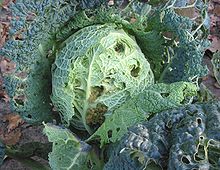Coal owl
| Coal owl | ||||||||||||
|---|---|---|---|---|---|---|---|---|---|---|---|---|

Coal owl ( Mamestra brassicae ) with pupa |
||||||||||||
| Systematics | ||||||||||||
|
||||||||||||
| Scientific name | ||||||||||||
| Mamestra brassicae | ||||||||||||
| ( Linnaeus , 1758) |
The cabbage moth ( Mamestra brassicae ) is a butterfly ( moth ) from the family of cutworms (Noctuidae).
features
butterfly
The wingspan is about 36 to 44 millimeters. The color of the fore wings is quite variable; from brown to greenish brown to grayish brown to blackish. Usually there are two or three transverse dark serrated wavy lines, the edge transverse lines are often lined with white. The kidney defect is whitish, the ring defect is filled with light brown.
egg
The egg is hemispherical, flattened at the bottom and strongly ribbed. It is pale white and has a dark, narrow ring and a dark spot on the upper pole.
Caterpillar
The color and pattern of the caterpillar vary considerably. It is dark green or brownish in color on the back, the back and side back lines, on the other hand, are whitish and bordered with slightly darker lines. The stripes on the side are relatively wide and yellowish. The caterpillars can be found from late June to late autumn.
Doll
The pupa is light red-brown with a conical cremaster (protrusion provided with thorns at the end of the abdomen). Two long, fine thorns stand close together on it.
Similar types and differences
The coal owl is different from other similar species, e.g. B. the reporting owl ( Anarta (Calocestra) trifolii ) through a thorn at the end of the tibiae of the front legs.
Geographical distribution and habitat
The species can be found all over Europe with the exception of northern Scandinavia and northern Russia. It occurs from the lowlands to about 2000 meters above sea level.
They are characteristic of the herbaceous vegetation in sunny forest clearings, forest edges and forest paths, banks of water, but also in gardens. Occasionally, there may be mass occurrences.
Way of life
The species flies in two to three overlapping generations from April to October, depending on the climatic conditions. In the higher altitudes of the Alps (up to 2,000 meters), however, only one generation occurs from the end of June to August. The moths are nocturnal, come to the light and can be baited with sugar. The eggs are laid or attached to the underside of the leaves of the forage plant in flat clusters of up to 100 pieces. The caterpillar lives individually on a variety of herbaceous plants such. B. Spinach ( Spinacia oleracea ), white carnation ( Melandrium album ), burning love ( Lychnis chalcedonica ), common columbine ( Aquilegia vulgaris ), turnip rape ( Brassica rapa ), rape ( Brassica napus ), vegetable cabbage ( Brassica oleracea ), garden radish ( Raphanus sativus ), peas ( Pisum spec.), Hyssop ( Hyssopus officinalis ), tomato ( Solanum lycopersicum ), black henbane ( Hyoscyamus niger ), tobacco ( Nicotiana spec.), Plantain ( Plantago major ), garden pumpkin ( Cucurbita pepo ), Marigold ( Calendula officinalis ), garden lettuce ( Lactuca sativa ) etc. Pupation takes place in the ground. The last generation pupa hibernates.
swell
Individual evidence
- ↑ H. Hacker, Lázló Ronkay, Márton Hreblay: Hadeninae I.- Noctuidae Europaeae, Volume 4. , p. 76, Sorø, 2002, ISBN 87-89430-07-7 .
literature
- Arno Bergmann: The large butterflies of Central Germany. Volume 4/1: Owls. Distribution, forms and communities. Urania-Verlag, Jena 1954, DNB 450378373 .
- Walter Forster , Theodor A. Wohlfahrt : The butterflies of Central Europe. Volume 4: Owls. (Noctuidae). Franckh'sche Verlagshandlung, Stuttgart 1971, ISBN 3-440-03752-5 .
- Manfred Koch : We determine butterflies. Volume 3: Owls. 2nd, expanded edition. Neumann, Leipzig / Radebeul 1972, DNB 760072930 .
Web links
- www.lepiforum.de: Taxonomy and photos
- Portal for butterflies - caterpillars
- Butterfly-Deutschlands.de
- Moths and Butterflies of Europe and North Africa (English)
- Homepage of Michael Stemmer: Moths - Owls
- Markku Savela: Lepidoptera and some other life forms (English)
- Mamestra brassicae at Fauna Europaea

